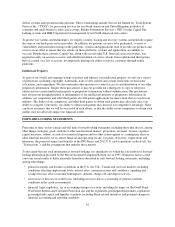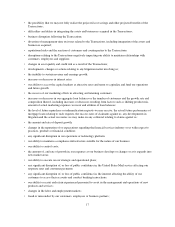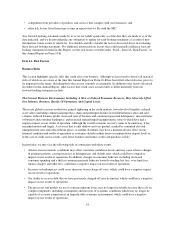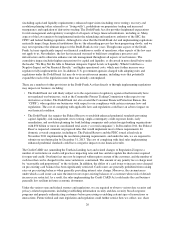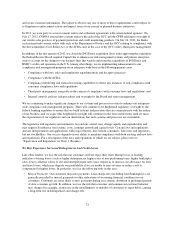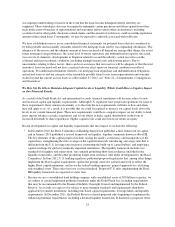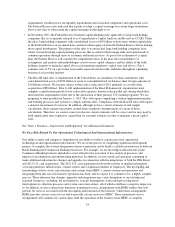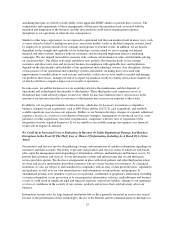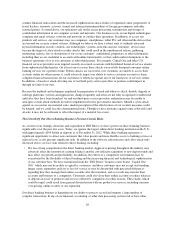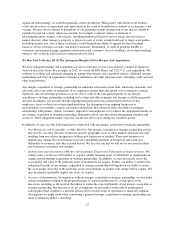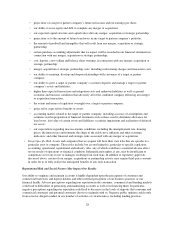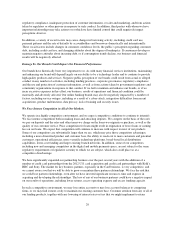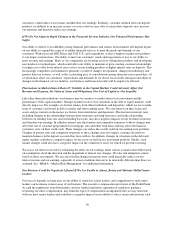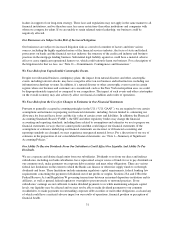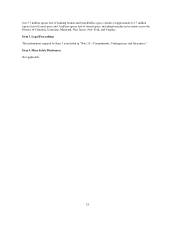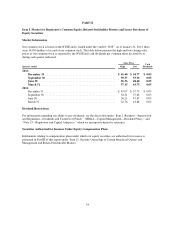Capital One 2012 Annual Report Download - page 44
Download and view the complete annual report
Please find page 44 of the 2012 Capital One annual report below. You can navigate through the pages in the report by either clicking on the pages listed below, or by using the keyword search tool below to find specific information within the annual report.and during that time we will rely on the ability of the applicable HSBC entities to provide these services. The
complexities and requirements of these arrangements will increase the operational risk associated with the
transition and integration of the business, and this increased risk could lead to unanticipated expenses,
disruptions to our operations or other adverse consequences.
Similar to other large corporations, we are exposed to operational risk that can manifest itself in many ways, such
as errors related to failed or inadequate processes, inaccurate models, faulty or disabled computer systems, fraud
by employees or persons outside of our company and exposure to external events. In addition, we are heavily
dependent on the strength and capability of our technology systems which we use to manage our internal
financial and other systems, interface with our customers and develop and implement effective marketing
campaigns. We also depend on models to measure risks, estimate certain financial values and determine pricing
on certain products. Our ability to develop and deliver new products that meet the needs of our existing
customers and attract new ones and to run our business in compliance with applicable laws and regulations
depends on the functionality and reliability of our operational and technology systems. Any disruptions, failures
or inaccuracies of our operational and technology systems and models, including those associated with
improvements or modifications to such systems and models, could cause us to be unable to market and manage
our products and services, manage our risk or to report our financial results in a timely and accurate manner, all
of which could have a negative impact on our results of operations.
In some cases, we and the businesses we are acquiring outsource the maintenance and development of
operational and technological functionality to third parties. These third parties may experience errors or
disruptions that could adversely impact us and over which we may have limited control. Any increase in the
amount of our infrastructure that we outsource to third parties may increase our exposure to these risks.
In addition, our on-going investments in infrastructure, which may be necessary to maintain a competitive
business, integrate recent acquisitions, such as ING Direct and the 2012 U.S. card acquisitions, and establish
scalable operations, may increase our expenses. Further, as our business develops, changes or expands, additional
expenses can arise as a result of a reevaluation of business strategies, management of outsourced services, asset
purchases or other acquisitions, structural reorganization, compliance with new laws or regulations or the
integration of newly acquired businesses. If we are unable to successfully manage our expenses, our financial
results will be negatively affected.
We Could Incur Increased Costs or Reductions In Revenue Or Suffer Reputational Damage And Business
Disruptions In the Event Of The Theft, Loss or Misuse Of Information, Including As A Result Of A Cyber-
Attack.
Our products and services involve the gathering, storage and transmission of sensitive information regarding our
customers and their accounts. Our ability to provide such products and services, many of which are web-based,
relies upon the management and safeguarding of information, software, methodologies and business secrets. To
provide these products and services, we use information systems and infrastructure that we and third party
service providers operate. We also have arrangements in place with retail partners and other third parties where
we share and receive information about their customers who are or may become our customers. As a financial
institution, we also are subject to and examined for compliance with an array of data protection laws, regulations
and guidance, as well as to our own internal privacy and information security policies and programs. If
unauthorized persons were somehow to get access to personal, confidential or proprietary information, including
customer information, in our possession or to our proprietary information, software, methodologies and business
secrets, it could result in significant legal and financial exposure, supervisory liability, damage to our reputation
or a loss of confidence in the security of our systems, products and services that could adversely affect our
business.
Information security risks for large financial institutions like us have generally increased in recent years in part
because of the proliferation of new technologies, the use of the Internet and telecommunications technologies to
25



